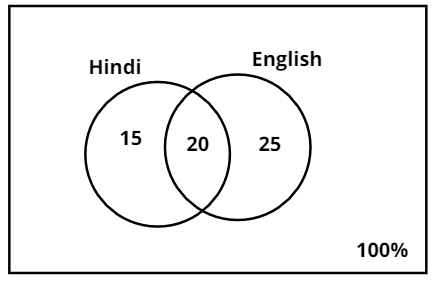
Answer
480k+ views
Hint: Here some of the students who failed in Hindi may also fail in English too. We are going to use union of sets to solve the given problem.
Let P(H) is the percentage of students who failed in Hindi and P(E) be the percentage of students who failed in English.
From the given information, we have
Percentage of students failed in Hindi = P (H) = 35%
Percentage of students failed in English = P (E) = 45%
Percentage of students who failed in both subjects = $P(H \cap E)$ =20%
$\because \left( {A \cup B} \right) = \left( A \right) + \left( B \right) - \left( {A \cap B} \right)$ [Union of sets]
The total fail percentage is
$ \Rightarrow P(H \cup E) = P(H) + P(E) - P(H \cap E)$
$ \Rightarrow P(H \cup E) = 35 + 45 - 20 = 60$
$ \Rightarrow $ 60% of students failed in at least one.
In class we have 100% students. Then number of students who passed in both subjects = 100% – 60% = 40%
$\therefore $40% of students passed in both the subjects.
Note:
We need to understand the given information carefully. We can also use Venn diagrams.

In the above diagram, if we observe we have individual percentages of each set. Percentage of students who failed only in Hindi is 15%, the percentage of students who failed only in English is 25% and the percentage of students who failed in both Hindi and English is 20%. A student will either pass or fail in the subject.
$ \Rightarrow $Pass percentage + fail percentage = 100%
When we get the total failure percentage, we can find the pass percentage easily.
Let P(H) is the percentage of students who failed in Hindi and P(E) be the percentage of students who failed in English.
From the given information, we have
Percentage of students failed in Hindi = P (H) = 35%
Percentage of students failed in English = P (E) = 45%
Percentage of students who failed in both subjects = $P(H \cap E)$ =20%
$\because \left( {A \cup B} \right) = \left( A \right) + \left( B \right) - \left( {A \cap B} \right)$ [Union of sets]
The total fail percentage is
$ \Rightarrow P(H \cup E) = P(H) + P(E) - P(H \cap E)$
$ \Rightarrow P(H \cup E) = 35 + 45 - 20 = 60$
$ \Rightarrow $ 60% of students failed in at least one.
In class we have 100% students. Then number of students who passed in both subjects = 100% – 60% = 40%
$\therefore $40% of students passed in both the subjects.
Note:
We need to understand the given information carefully. We can also use Venn diagrams.

In the above diagram, if we observe we have individual percentages of each set. Percentage of students who failed only in Hindi is 15%, the percentage of students who failed only in English is 25% and the percentage of students who failed in both Hindi and English is 20%. A student will either pass or fail in the subject.
$ \Rightarrow $Pass percentage + fail percentage = 100%
When we get the total failure percentage, we can find the pass percentage easily.
Recently Updated Pages
How many sigma and pi bonds are present in HCequiv class 11 chemistry CBSE

Mark and label the given geoinformation on the outline class 11 social science CBSE

When people say No pun intended what does that mea class 8 english CBSE

Name the states which share their boundary with Indias class 9 social science CBSE

Give an account of the Northern Plains of India class 9 social science CBSE

Change the following sentences into negative and interrogative class 10 english CBSE

Trending doubts
Fill the blanks with the suitable prepositions 1 The class 9 english CBSE

The Equation xxx + 2 is Satisfied when x is Equal to Class 10 Maths

In Indian rupees 1 trillion is equal to how many c class 8 maths CBSE

Which are the Top 10 Largest Countries of the World?

How do you graph the function fx 4x class 9 maths CBSE

Give 10 examples for herbs , shrubs , climbers , creepers

Difference Between Plant Cell and Animal Cell

Difference between Prokaryotic cell and Eukaryotic class 11 biology CBSE

Why is there a time difference of about 5 hours between class 10 social science CBSE



